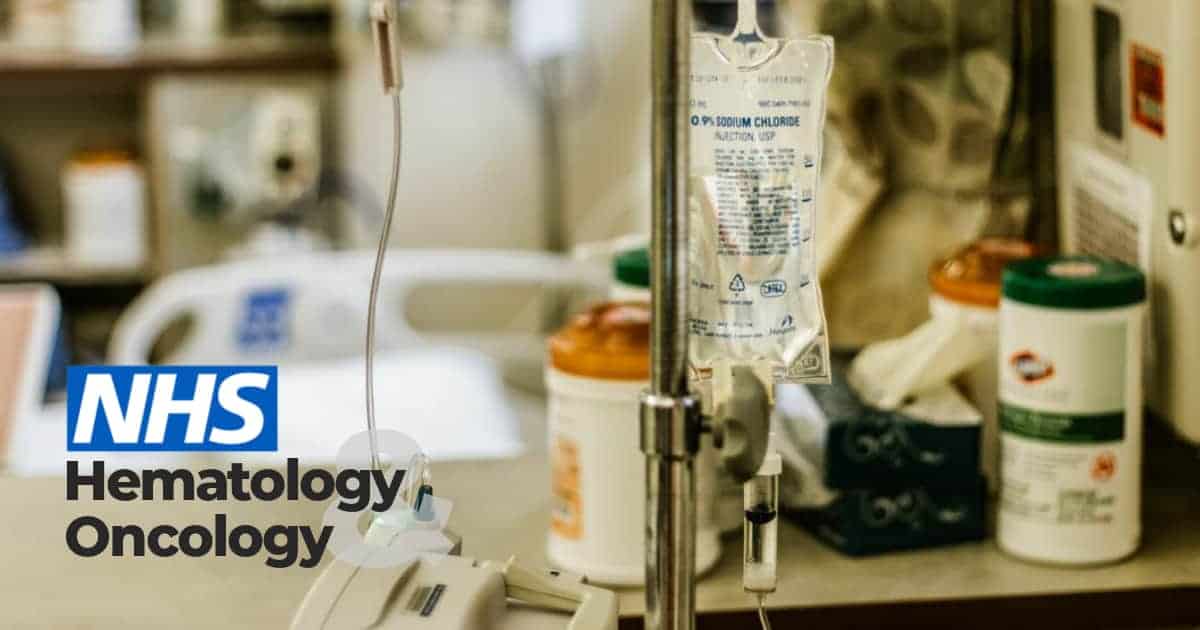Working in Hematology and Oncology in the NHS

Haematology and oncology in the NHS are interesting departments to work in. They test you in not only how you approach the different complications associated with patient care, but also how you relate and express yourself to the patient and their family. There is a good deal of breaking bad news, being empathetic, and handling patients who may need palliation. The speciality as a whole can be emotionally exhausting but very rewarding.
What can you expect?
Patients in this department are often directly admitted to the ward instead of having to go through A&E or AMU/CDU. This is because they are often susceptible to picking up infections via the usual route. If this occurs, you will need to clerk them on the ward. Patients may also come indirectly if they require a biopsy done for histological confirmation.
You would need to assess these patients as you would any other patient you’d be clerking in on an acute ward. It’s important that you attend to them quickly as they more often than not are acutely ill and require immediate treatment. Here are a list of common cases you may face:
- Neutropenic sepsis
- Hypercalcemia
- Hyperkalemia
- Hypomagnesemia
- Dehydration
Daily tasks on the hematology or oncology ward in the NHS
Check patient’s performance status
When you see a patient, you may find by looking through previous notes and clinic letters that they have been allotted a performance status. This status is very important for ongoing care as it can change the type of treatment given to a patient. It is described as follows:
- Performance status 0: Able to go about normal activities without any hindrance.
- Performance status 1: Ambulatory and can take care of self, but limited physically in doing things that would be strenuous. Can do light tasks/office work.
- Performance status 2: Ambulatory but to a lesser degree, spending half or more of their hours out of bed. Can take care of self. Unable to work.
- Performance status 3: Restricted to bed/not ambulant for half or more of their hours. Has difficulty in taking care of self. Patient is obviously symptomatic.
- Performance status 4: Bed bound. Cannot take care of self at all, completely reliant on help from others.
Know bits and bobs about different therapies
You will also have to at least have a basic idea regarding the various forms of chemotherapy that patients are on and their complications. The best people to help you understand who is getting what and why are the specialist nurses. They are an absolute godsend and if ever you are confused or have any questions, ask them.
Mastering the art of referral
Working within haematology or oncology opens you up to the need to bring in the input of a variety of specialities in the NHS. One may erroneously think that once a patient has been diagnosed with cancer that it is up to their cancer specialist to figure out the best plan and treatment course. You will also find that it is necessary to consult with dietitians, speech and language therapists, physiotherapists, occupational therapists, and other specialities such as interventional radiology, palliative care, cardiology, respiratory medicine, gastroenterology, etc. There are often many multi-disciplinary meetings that occur where consultants take advice from other specialists about how best to go about treating their patients.
Working as a part of Multidisciplinary team (MDT)
There will also be a day clinic that is run by speciality-specific nurse practitioners. You may be asked to review patients that they may feel could require admission or just to give them a once over if they feel it needs doing. There will also be an area where patients will be receiving chemotherapy that is also completely nurse-led. You may be asked to prescribe anti-emetics or even just check on patients there but for the most part, it is also nurse-led.
Palliative Care: Intertwined with hematology and oncology
While a separate speciality on its own, palliative care plays a huge role in the ongoing management of many of your patients. It is an unfortunate reality that many of the times these patients are admitted to a hematology or oncology ward in the NHS it is because they are in their last fight against cancer, for which reason palliative measures are often put into place. The NHS has a wonderful initiative by way of Macmillan support which helps cancer patients and their families get more information and education regarding their ongoing care and needs.

Palliative care doesn’t always mean that the patient will not be leaving the hospital. There are aspects to palliative care related to relieving symptoms and managing pain associated with ongoing care. The palliative care team can also give input in relation to what medications can be adjusted to ensure the patient is comfortable in their last days. Occasionally you will find that everything has been done for a patient and despite aggressive treatment and care, the patient isn’t responding well. Consultants and registrars then assess the situation given the amount of treatment administered, the patient’s performance status, the wishes of the patient/family, and see if it is the correct decision to opt for placing the patient on end of life care (EOL) or the last days of life (LDOL) pathway.
Before this type of pathway is put into place, it’s something that needs to be thoroughly weighed and discussed with the family. There is paperwork that should be completed regarding the pathway, and with it comes a list of medications to be prescribed. These medications don’t all need to be prescribed at once; only prescribe what is appropriate given the patient’s current situation and the others can be left as needed (PRN). If you are going to be prescribing regular medications as per the EOL pathway, all unnecessary medications are struck off, IV fluids stopped, and comfort care measures and medications are started. The regular medications that are to be given will be administered by a syringe driver, which provides subcutaneous 24 hours medication.
A skill to sharpen: Breaking Bad News
As a junior doctor, you should never be put in a position where you alone are breaking bad news to a patient, but at the same time, you should not shirk away from the opportunity to sit in on a registrar or consultant doing so. If appropriate, you can also speak to your registrar or consultant to allow you to participate in these discussions when you feel confident to do so.
While initially, the prospect of sitting patients with their family or even perhaps just speaking to family alone (with permission if needed) can seem difficult or near about impossible, it is a skill that is vital to have. Families (and nurses!) appreciate doctors who communicate well, and an essential part of that communication is often knowing how to properly break bad news.
There isn’t any perfect way (at least in my opinion) to do it, and I’ve found that initially we will all stumble and hem and haw when put on the spot, so it’s a good idea to observe as many senior doctors following through as you can. This will give you a foundation to build upon your own experience and you will have a starting point. If you can, try and sit with another doctor and hold practice sessions on how you’d speak to a patient.
It’s always a good idea to give this type of information in a private setting, so if the patient isn’t already in a side room, try and see if something can be arranged. If the family are there, brief them of what’s been done so far. Keep as much as your team there as possible- the nurse who has been looking after the patient, the nurse in charge, any other doctors immediately involved in their care, etc. If appropriate, see if you can arrange for a nurse or doctor from palliative care to be there as well.
The most important part of this entire process is hearing the patient and their family out. They may have many questions and concerns, and it is our duty to alleviate their worries as best we can. If ever you are put into a situation where you are asked something that you do not have the answer to, please refrain from providing false hope or unsure responses. Instead, explain that you are not certain and that you will try and find out and get back to them.
Useful tools for the hematology or oncology ward in the NHS
There are certain apps that will make your life infinitely easier, so keep them on your phone. The BNF has a directory of drugs that you can look up, along with treatment summaries, basic guidance, and wound care, among other features. It is something you will use regularly when you need to prescribe treatments or check for interactions.
Textbook-wise, you can’t go wrong with the Oxford handbook of hematology or the Oxford Handbook of oncology.
I once asked a palliative care consultant why they did what they did and how it felt for them to be working in a speciality as emotionally demanding as palliative care. Their response is something I believe we should all keep in mind when we treat patients who can become very ill- I am given the opportunity to make someone’s last days comfortable and do everything in my power to ensure their dignity is maintained while doing it.
How to get become a hematologist/oncologist in the UK?
If you wish to pursue hematology or oncology as a speciality in the UK, and you meet the qualifications for Internal Medicine Training (IMT), you can apply for it. As these specialities are non-acute, you would only need to complete two years of IMT instead of three (which is required if you want to pursue an acute speciality like cardiology, respiratory, etc). Upon completion of IMT, you would then apply for a speciality training post in hematology or oncology.
Alternatively, if you have already completed MRCP and wish to apply directly into speciality training, you may do so as long as your core competencies are signed off.
Good luck on the ward!

